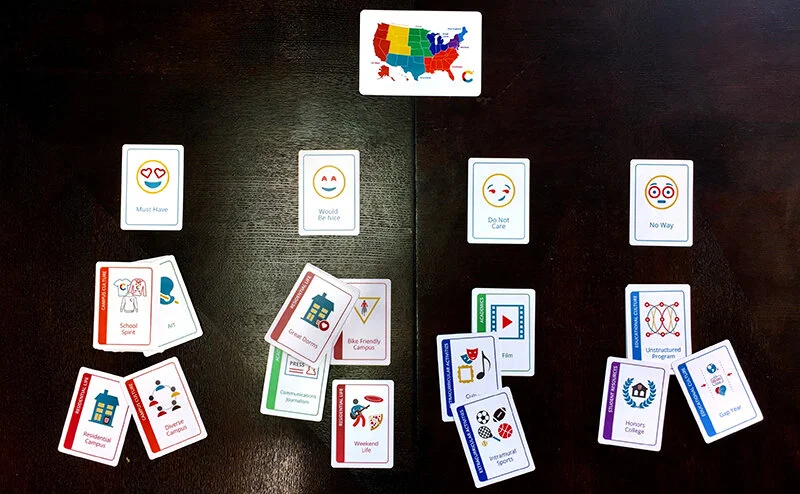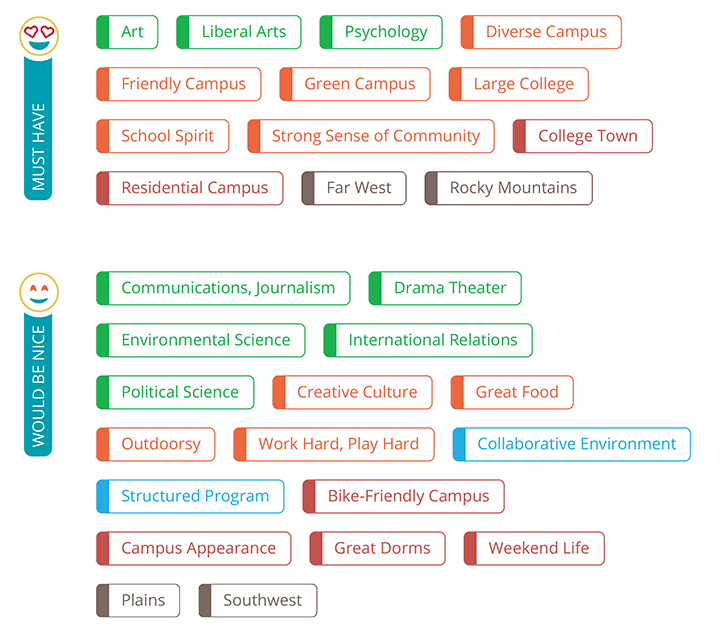We all have a way of doing things that makes our counseling run more smoothly—a system for more quickly and meaningfully engaging with our students, while balancing family communication and the realities of a complicated college admissions process. Over the last month, I started doing something entirely new, changing up my streamlined system that had worked so well for so long. I was curious how things would shake out.
As I brought out the new cards and set them on the table, my student chuckled—this was new. Usually students light up at the chance to sort the original College Choice 101 cards and do something fun related to the college process for a change, but the emoji choice cards on this new set shifted her mindset.
She loosened up and dug right into her interests, considering things she had never imagined would be important as she contemplated her college options, and she talked—a lot. Anyone who has used the cards in their work with students knows that you learn a lot watching the way students sort their cards—some toss them quickly, others gaze at each one and ask pointed questions, and still others use the Solitaire approach to stacking them so they can see each one and move them around accordingly.
But it was the color-coded categories that got my attention as I sat and watched her assess each card. I started to see patterns arising in her interests—the cards in various categories like Campus Culture and Residential Life seemed to be ending up in the Must Have pile, while those in Extracurricular Activities and Student Resources gravitated to her Don’t Care pile.
Discussions of seemingly conflicting cards in the Must Have pile made her ponder her options. She knew she did better in small, discussion-based classes, but she wanted school spirit, big-time sports, and a large college. We discussed how to resolve these as she continued to open up about her learning style, admitting she benefited from being pushed by her peers, and the conversation moved quickly to a new level.
As she finished her sort and I had a chance to review what was most important to her, we moved the discussion to “location.” We talked geographic diversity, the potential for more merit aid further away, and the pros and cons of various choices. We focused on her interest in big weekend life on campus, particularly if she were to travel far from home. We then discussed the downside of finding herself at a more regional campus further from home that offered merit aid but had students who often went home on the weekend, versus places that drew from further away and had an active residential life on the weekend but might offer less in merit. Lots to ponder.
The map is a feature that we added because so many students were ruling out various parts of the country early in the process before they could explore places they had never considered, where they might get more aid or have an entirely new experience. Colleges are now reaching further for students. Making geography a part of the conversation after students select their deeper preferences means that they can think about additional schools that might be a great fit, ones that might never have been included had they ruled out various regions early on.
After my student left, I browsed through her four piles and considered her preferences, but it was when I logged into my Corsava account and started entering her results that things felt different. For the first time, I had six card categories, and I began to see patterns that would help as her college list came into view. I could see how this report was going to generate more discussion at home and give her time to think about various aspects of the college choice process she had never envisioned.
It was fun to sit and enter her card choices—it got me thinking about her options and which colleges might match her criteria. I knew this report was just the beginning of her journey through the process and would open lots of discussions as she focused on what she wanted, not what others expected of her. She had taken ownership of the process by looking more deeply into what mattered to her, and I was along for the ride as I considered colleges that would meet her needs.
After I finished updating her card sort results, it was on to the map. I clicked on the areas that we discussed and rated them accordingly so that she could include location information in her college search process. Now I could share her preferences with her and her family so that she could keep it moving forward. Whether we met again or not, she would have tools to begin the search process at a granular level. During visits, when meeting with college representatives at her high school, and when talking to her family about her aspirations and goals, she had something to turn to as she reflected on her unique path. Whether it meant finding a place with a more collaborative environment or one that provided access to professors and a strong residential community, she knew what she needed to be successful. She was off and running!





